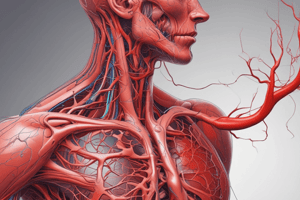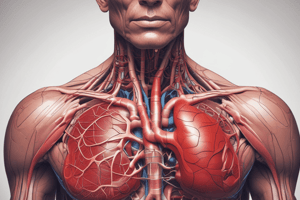Podcast
Questions and Answers
Which component of blood is responsible for the transportation of nutrients, hormones, and oxygen to cells?
Which component of blood is responsible for the transportation of nutrients, hormones, and oxygen to cells?
- Red blood cells
- Blood plasma (correct)
- Buffy coat
- Cellular portion
What is the normal pH range of blood?
What is the normal pH range of blood?
- 6.5-7.0
- 7.35-7.45 (correct)
- 7.4-7.6
- 7.0-7.3
What gives arterial blood its bright red color?
What gives arterial blood its bright red color?
- High levels of oxygen (correct)
- High carbon dioxide levels
- Presence of antibodies
- Low pH balance
Which of the following statements about blood volume is accurate?
Which of the following statements about blood volume is accurate?
What is one of the protective functions of blood?
What is one of the protective functions of blood?
Why does venous blood have a lower pH than arterial blood?
Why does venous blood have a lower pH than arterial blood?
What factors influence the volume of blood in an individual?
What factors influence the volume of blood in an individual?
Which of the following best describes the composition of blood?
Which of the following best describes the composition of blood?
What is the role of bicarbonate ions in blood regulation?
What is the role of bicarbonate ions in blood regulation?
How does the temperature regulation functionality of blood work?
How does the temperature regulation functionality of blood work?
Flashcards
What is blood?
What is blood?
A liquid connective tissue that circulates throughout the body, driven by the heart's pumping action.
What are the main transportation functions of blood?
What are the main transportation functions of blood?
Blood delivers nutrients like amino acids, lipids, and glucose, as well as hormones and oxygen to cells. It also carries waste products and carbon dioxide away from cells.
Explain the regulatory roles of blood.
Explain the regulatory roles of blood.
Blood helps maintain a stable pH (7.35-7.45) by buffering the body's fluids. It also regulates body temperature through water circulation and vasodilation.
What are the protective functions of blood?
What are the protective functions of blood?
Signup and view all the flashcards
What is the typical blood volume in humans?
What is the typical blood volume in humans?
Signup and view all the flashcards
Why is arterial blood bright red while venous blood is darker?
Why is arterial blood bright red while venous blood is darker?
Signup and view all the flashcards
What is the normal pH range of blood? Why is venous blood slightly more acidic?
What is the normal pH range of blood? Why is venous blood slightly more acidic?
Signup and view all the flashcards
What are the two main components of blood?
What are the two main components of blood?
Signup and view all the flashcards
What is the approximate blood volume in an average adult? How much of it is plasma?
What is the approximate blood volume in an average adult? How much of it is plasma?
Signup and view all the flashcards
What are the functions of the cellular components of blood?
What are the functions of the cellular components of blood?
Signup and view all the flashcards
Study Notes
Physiology (0603302) Ch.2 Blood
- Blood is a liquid connective tissue circulating through blood vessels, pumped by the heart.
- Functions:
- Transportation:
- Transports nutrients (amino acids, lipids, glucose), hormones, and oxygen to cells.
- Transports wastes and carbon dioxide away from cells.
- Regulation:
- pH buffering (7.35-7.45): Role of hydrogen and bicarbonate ions.
- Body temperature regulation (water and vasodilation of surface vessels).
- Protection:
- Clot formation: Minimizes blood loss when a vessel is damaged.
- Protection against foreign substances (antibodies and white blood cells).
- Transportation:
Characteristics of Blood
- Blood volume:
- Males: 5-6 liters
- Females: 4-5 liters
- Varies based on size and gender of individual.
- Color:
- Red, with arterial blood being brighter (higher oxygen content) and venous blood being darker (lower oxygen content).
- pH:
- Arterial blood (7.35-7.45)
- Venous blood (7.32-7.42)
Blood Composition
- Cellular portion (formed elements):
- Lower portion in a blood sample tube (buffy coat + red blood cells).
- Fluid portion (plasma):
- Upper portion in a blood sample tube -The average adult has a blood volume of roughly 5 liters. -The blood plasma volume totals of 2.7-3.0 liters in an average human.
Components of Blood
- Plasma (Fluid portion):
- Water (91-92%): Transport medium for materials carried in the blood.
- Proteins (6-8%): Maintain blood volume and blood pressure.
- Albumin (60%): Transport protein, steroid hormones, & maintains blood volume & pressure.
- Globulins (35%): Transport hydrophobic lipids, fat-soluble vitamins, ions and hormones; Gamma is antibodies for immunity.
- Fibrinogen (4%): Coagulation protein.
- Regulatory proteins (<1%): Enzymes, proenzymes and hormones.
- Other solutes (1-2%): Electrolytes, organic nutrients (ATP production, growth, maintenance of cells), organic wastes (urea, creatinine, bilirubin), dissolved gases (O2, CO2).
1. Erythrocytes (Red Blood Cells)
- Number: 4.6-6.2 million/mm³ in men, 4.5-5.1 million/mm³ in women.
- Shape: Flat, bi-concave discs lacking a nucleus and mitochondria.
- Size: 7.5 µm in diameter and 2.5 µm thick.
- Derived from precursors in bone marrow
- Importance of shape: Provides increased surface area for diffusion of O2 and CO2.
- Functions:
- Transporting hemoglobin, which carries oxygen from lungs to tissues.
- Contains carbonic anhydrase, catalysing the reversible reaction between carbon dioxide and water, creating carbonic acid (H2CO3).
- Hemoglobin is responsible for most of the blood's acid-base buffering power.
- Life span: 70-150 days.
- Degradation: Macrophages in the liver and spleen phagocytose damaged RBCs; hemoglobin is broken down into heme and globin; heme breaks down to iron (recycled), biliverdin, and bilirubin (excreted in bile).
Synthesis of Erythrocytes
- Areas producing RBCs:
- Yolk sac (early embryonic life)
- Liver, spleen, lymph nodes (mid-gestation)
- Bone marrow (later gestation and throughout life).
Regulation of Red Blood Cell Production
- Decreased tissue oxygenation is the most important regulator of red blood cell production.
- Other factors include low oxygen concentration, high altitude, lung diseases, and heart failure.
- Erythropoietin (EPO) is secreted by the kidney in response to low oxygen levels, stimulating erythropoiesis (RBC production) in bone marrow.
2. Leukocytes (White Blood Cells)
- Mobile units of the immune system, destroying old/abnormal cells and attacking infections like bacteria and viruses.
- Phagocytosis and antibody formation are common mechanisms.
- Types & functions:
- Neutrophils, monocytes, eosinophils, basophils, lymphocytes (B & T cells). - Function in innate and adaptive immunity.
- Lifespan: 13–20 days.
- Location of production: Partially in bone marrow, partially in lymph tissue.
3. Thrombocytes (Platelets)
- Cellular fragments (lack nuclei) from megakaryocytes in bone marrow.
- Irregularly shaped.
- Critical for hemostasis (stopping bleeding and maintaining vascular integrity).
- Release factors to stimulate the coagulation cascade, producing fibrin to form a clot.
- Average lifespan: 7-14 days.
Blood Clotting (Hemostasis)
- Process of stopping bleeding.
- Steps:
- Vessel damage.
- Vasoconstriction slows blood flow.
- Primary hemostatic plug forms, through aggregation of platelets.
- Secondary hemostatic plug from fibrin reinforces the primary plug.
- Clot retracts and endothelium is repaired.
- Steps:
Plasma vs Serum
- Plasma is the liquid part of whole blood containing clotting factors.
- Serum is plasma without clotting factors, obtained after blood clotting in tubes without anticoagulants.
Clinical Applications of Blood
- Anemia (reduced oxygen-carrying capacity)
- Nutritional, pernicious, aplastic
- Polycythemia (excess RBCs, occurs in high altitude or rare cases)
Clinical Applications: Assessment of Blood
- Mucous membrane color (pink=well-oxygenated, blue=poorly oxygenated).
- Capillary refill time (CRT) (normal <2 seconds; delayed CRT indicates perfusion issues).
Studying That Suits You
Use AI to generate personalized quizzes and flashcards to suit your learning preferences.
Related Documents
Description
Explore the essential functions and characteristics of blood in this quiz based on Physiology Chapter 2. Discover how blood acts as a connective tissue, its role in transportation, regulation, and protection, as well as its volume and color differences. Test your knowledge on this vital component of the human body.




